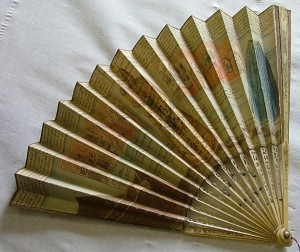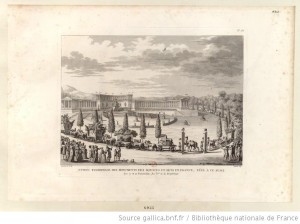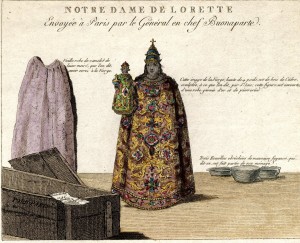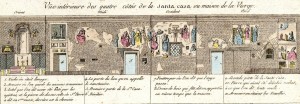My colleague Cath Casley has noticed a pretty fan in the Ashmolean’s collection which seems to relate to some of the prints in which Douce was interested -I am copying her message below:
Found this fan within the collection of Western Art at the Ashmolean which depicts the Virgin of Loreto. I know I have seen prints within the Douce collection which feature this subject. The fan is 18th century and French, bequeathed by Professor Ingram Bywater, 1915.

Anonymous French, Notre Dame de Lorette, c. 1797, ivory and hand-coloured etching (Ashmolean Museum, WA1915.33.2)
Prints were often used to make fans, but this one is unusual because of its subject. The fan reproduces, in a slightly different format, the same elements that can be seen in this broadside from Douce’s collection:

Jacques-Louis Bance, Notre Dame de Lorette, c. 1797, hand-coloured etching (Ashmolean Museum, Oxford)
In the fan, the image of the Virgin and Child appears in the centre, with an open crate at left and a cloak said to have been worn by the Virgin at right. Exactly the same objects appear in the broadside, although their arrangement has changed:
The inscription ‘Procés verbal ce 26 Pluviôse an 5eme’ on a piece of paper on the edge of the crate refers to the Directory’s plans to confiscate works of art and other valuable objects in the course of Napoleon’s Italian campaign. The convoy arrived in Paris in late July 1798 and it included the Apollo Belvedere, the Medici Venus, the Laocoön group, paintings by Raphael and Correggio, natural history collections, and manuscripts from the Vatican, among other things. As Dorothy M. Quynn explains, ‘the popular interests were catered to by the inclusion of the animals [from Italian zoos] and of such famous religious relics as the miracle-working wooden Virgin of Loreto, attributed to [St] Luke’:

A. Girardet and P.-G. Berthault, Entrée triomphale des monuments des sciences et des arts en France , etching and engraving, 1802 (Source gallica.bnf.fr / Bibliothèque Nationale de France)
The images on both sides of the Virgin are taken from the depiction of the walls of the Basilica of the Santa Casa in Loreto:
Douce’s print provides us with a more precise date and context for the fan, which might have been produced as a souvenir to mark the public celebrations surrounding the arrival of Napoleon’s convoy in Paris (so it would be the equivalent of a Diamond Jubilee mug).


